Global Home Heating Equipment Market Forecast
- Home heating equipment market size to attain a valuation of US$7.02 Bn in 2030, from approximately US$4.8 Bn recorded in 2022
- Market valuation slated for a CAGR of 5.6% during 2023 - 2030
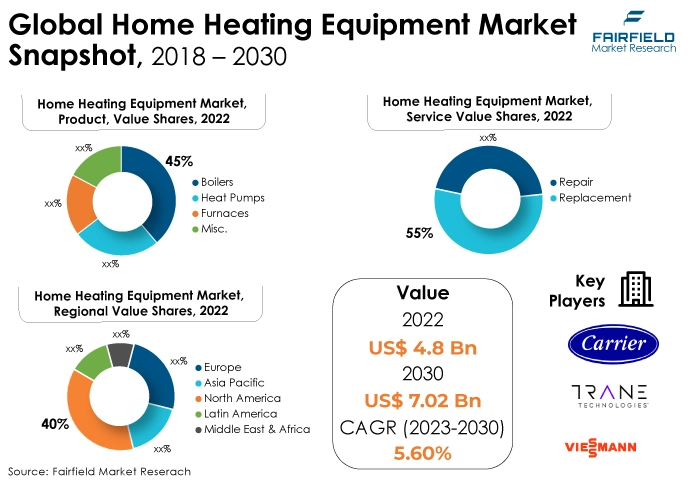
Quick Report Digest
- The key trend anticipated to fuel the home heating equipment market growth is increasing demand for sustainable and environmentally friendly heating options, which is one of the most important trends in the home heating service market.
- Another major market trend expected to fuel the home heating equipment market growth is the need to reduce carbon emissions and growing climate change awareness are the main factors driving this shift.
- In 2022, the boilers category dominated the industry. Boilers are essential to the provision of home heating equipment because they heat and supply hot water to homes via a central heating system.
- In terms of market share for home heating equipment globally, the natural gas segment is anticipated to dominate. It is a preferred option for many heating applications due to its use in fuel delivery for heating units.
- In 2022, the replacement category in the services segment controlled the market. The upgrading or replacement of your current heating system with a brand-new, more effective one constitutes the replacement of a home heating service.
- One of the biggest obstacles to the market for home heating equipment is the increasing focus on environmental regulations and sustainability issues.
- North America is anticipated to account for the largest share of the global home heating equipment market due to different climate zones in Asia Pacific, from the milder climates in the southern United States to the chilly winters of northern Canada.
- The market for home heating equipment is expanding in Asia Pacific due to rapid urbanisation and housing growth is taking place in the region, which is fuelling a boom in housing construction. The newly constructed residential communities and commercial structures, increases the demand for heating services, such as central heating systems and hot water supply.
A Look Back and a Look Forward - Comparative Analysis
The market for home heating equipment has grown in popularity because of factors such as the growing emphasis on energy efficiency and sustainability is a significant driver in the market for home heating equipment. As a result, there is a need for heating systems that are more environmentally and energy conscious. In response, service providers are providing green alternatives like heat pumps and solar heating as well as energy-efficient heating systems.
Rapid improvements in heating technology have fuelled the market. A growing number of people are using smart thermostats, IoT-enabled heating systems, and remote-control apps. Homeowners now have more control over their heating systems thanks to these technologies, resulting in energy savings and increased comfort.
The use of renewable energy sources in home heating systems is expanding. To lessen reliance on fossil fuels, biomass heating, geothermal heat pumps, and solar panels are being used. Service providers are expanding their range of products and services to include hybrid heating systems that use both conventional and renewable energy sources.
Government programs and incentives have a major impact on how the market for home heating equipment is shaped. Governments in many areas provide tax breaks, rebates, and subsidies to promote the use of renewable and energy-efficient heating systems. Regulations aimed at lowering carbon emissions and enhancing energy efficiency also push the market toward cleaner and more sustainable heating options.
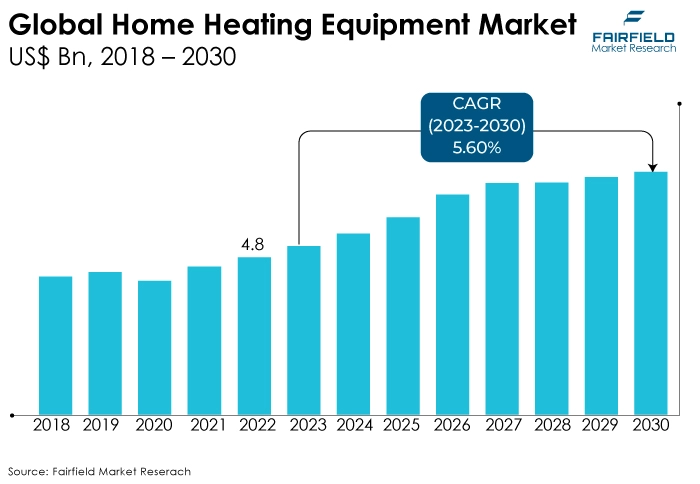
Key Growth Determinants
- Shift in Favour of Environmentally Sustainable Heating Options
The increasing demand for sustainable and environmentally friendly heating options is one of the most important trends in the home heating service market. The need to reduce carbon emissions and growing climate change awareness are the main factors driving this shift.
The interest in renewable energy sources like solar heating, geothermal heat pumps, and biomass heating systems is thus growing. Owners of homes are increasingly looking for alternatives that not only offer comfort but also adhere to their environmental values.
- Energy Efficiency Improvements
The home heating service market is increasingly focusing on energy efficiency. Customers are looking for heating systems that are both economical to use and friendly to the environment.
Modern insulation materials, high-efficiency furnaces, and smart thermostats are becoming more and more popular because of their ability to lower heating costs and consumption of energy. For existing heating systems to operate more efficiently, heating service providers are increasingly providing energy audits and retrofitting services.
- Smart Home Integration
The incorporation of smart home technology is transforming the delivery of heating services. Homeowners can use smartphone apps to remotely monitor and control their heating systems thanks to smart thermostats and heating control systems. Energy savings and increased convenience result from these systems' ability to learn user preferences and optimise heating schedules. The heating service industry is embracing these technologies because of the trend toward smart homes.
An emerging trend called heating as a service (HaaS) allows homeowners to subscribe to heating services rather than buying and maintaining heating equipment. With this model, consumers can take advantage of cutting-edge, energy-efficient heating systems without incurring initial costs or ongoing maintenance obligations. A hassle-free heating solution is provided by HaaS providers, who take care of installation, upkeep, and repairs.
Major Growth Barriers
- Sustainability Issues, and Environmental Regulations
One of the biggest challenges facing the market for home heating equipment is the increasing focus on environmental regulations and sustainability issues. Globally, governments and environmental organisations are enacting more stringent laws to cut carbon emissions and promote cleaner energy sources.
This change is forcing the heating industry to switch from fossil fuels like heating oil and natural gas to more environmentally friendly options like heat pumps, solar heating, and biomass systems. While these adjustments are essential for reducing climate change, they present difficulties for conventional heating service providers who must adjust to new laws and technologies.
- High Upfront Costs
High-efficiency furnaces and other energy-efficient heating systems, like geothermal heat pumps, offer long-term savings but frequently have expensive initial installation costs. The market for these technologies can grow only so far if homeowners are discouraged by the cost of upgrading to more environmentally friendly heating systems.
Key Trends and Opportunities to Look at
- Demographic Trends
Changing demographics, such as urbanisation and aging populations, impact the market. Older homeowners may prioritise convenience and comfort in heating systems, increasing the demand for intelligent and automated solutions.
Urbanisation trends can influence the type of heating systems preferred, with smaller living spaces favouring more efficient and compact options.
- Increasing Solutions for Eco-friendly Packaging
The market for home heating equipment is impacted by economic factors such as income levels and energy prices. Rising energy costs may encourage homeowners to make investments in energy-efficient systems to lower their heating costs.
Economic downturns, on the other hand, might result in postponed maintenance or the repair of current heating systems rather than their replacement.
- Climate Change and Extreme Weather Events
Extreme cold snaps and heat waves brought on by climate change are increasing the demand for dependable and effective heating systems. Homeowners seek heating options that can endure severe weather conditions and deliver reliable comfort. High-efficiency furnaces, heat pumps, and emergency heating systems are now more popular due to this.
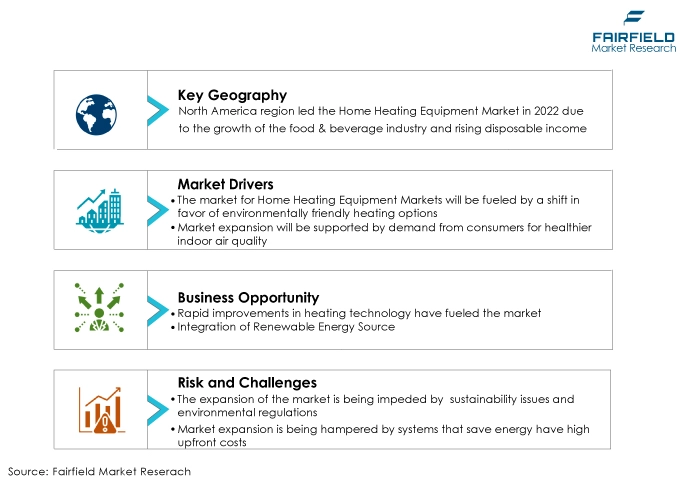
How Does the Regulatory Scenario Shape this Industry?
Energy efficiency standards for heating apparatus, including furnaces, boilers, and heat pumps, have been established in several nations and regions. These standards specify the minimal energy efficiency standards that heating systems must meet to be sold or installed. Environmental regulations are becoming stricter to cut greenhouse gas emissions and enhance air quality.
The types of fuels and technologies used for home heating are affected by these regulations. Regulations might, for instance, encourage the use of cleaner fuels or set limits on the pollutants that heating equipment can emit. Access to more economical and energy-efficient heating options is ensured for consumers through compliance with these standards.
The market for home heating equipment places a high priority on safety. To prevent accidents, fires, and carbon monoxide poisoning, regulations establish safety standards for the installation, upkeep, and use of heating systems. To protect their clients and keep their licenses, heating service providers must adhere to safety regulations.
Fairfield’s Ranking Board
Top Segments
- Boilers Prominent over Furnaces
The boilers segment dominated the market in 2022. In many home heating systems, boilers are used to heat the water. Then, a method of pipes and radiators spread throughout the house are used to transport the heated water. Warmth is effectively released into the rooms as the hot water passes through the radiators, warming the interior.
Furthermore, the furnaces category is projected to have the fastest market growth. Various safety features are included in modern boilers to guard against problems like overheating, pressure buildup, and gas leaks. These safety measures ensure the security of homeowners and their properties.
- Natural Gas Heating Fuel Will Surge Ahead
In 2022, the natural gas category dominated the industry. For home heating, natural gas is frequently used. It is commonly used as a fuel source for central heating systems, like furnaces and boilers, in homes. Pipelines transport natural gas to homes, where it is burned to create heat. It is renowned for consistently providing warmth during the colder months with efficiency and dependability.
The heating oil category is anticipated to grow substantially throughout the projected period. Both residential and commercial heating can be effectively accomplished with natural gas. For a consistent and dependable supply of hot water for bathing, cleaning, and other uses, many homes, and businesses use natural gas water heaters.
- Replacement Expected to be the Leading Segment
The replacement segment dominated the market in 2022. The condition and efficiency of the current heating system must be evaluated in the first step. Age, efficiency, heating capacity, and any ongoing problems or repairs. To determine whether your current system is costing more than it should, you might also want to examine your energy bills. An expert heating contractor can assist with this evaluation.
The repair category is expected to experience the fastest growth within the forecast time frame. The old heating system must be taken out and a new one put in during the installation process. Included in this are the electrical connections, fuel supply lines, and, if applicable, ductwork connections for the heating system. For the system to operate effectively and safely, proper installation is essential.
Regional Frontrunners
North America Remains the Largest Revenue Contributing Region
There are many different climate zones in North America, from the milder climates in the southern United States to the chilly winters of northern Canada. To meet the needs of different regional climates, this diversity drives demand for a variety of heating systems, such as forced-air furnaces, boilers, heat pumps, and radiant heating.
Natural gas is a cheap and widely accessible fuel for heating in North America, especially in the United States. Due to its affordability and dependability, it is a popular option among many homeowners.
A growing market for high-efficiency heating systems has resulted from the strict energy efficiency standards and laws that apply to both the US, and Canada. Businesses and homeowners are encouraged to spend money on heating systems that use less energy and cost less to operate.
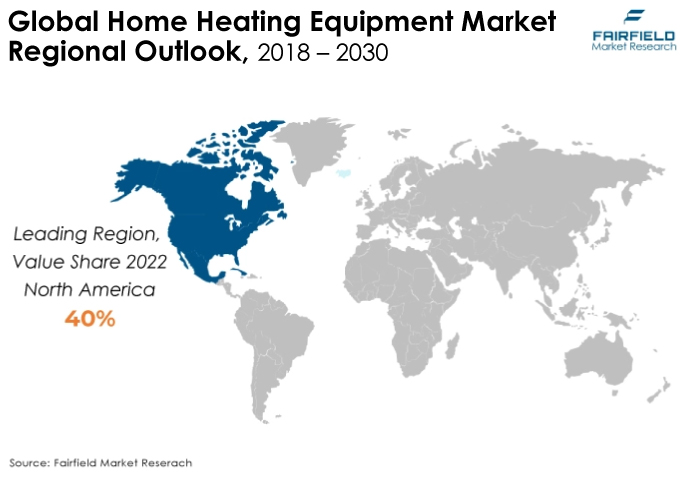
Asia Pacific Grows Stronger as Preference for Sustainable Heating Technologies Rises
Winters in some regions of the Asia Pacific region, including northern China, and parts of Russia, are bitterly cold. For the comfort and safety of the residents, this necessitates the use of efficient and dependable heating solutions, such as district heating systems, central boilers, and radiant floor heating.
Many nations in the Asia Pacific region are placing a high priority on environmental sustainability and lowering greenhouse gas emissions. As a result, there is an increase in interest in sustainable heating technologies like heat pumps, solar heating, and biomass systems.
To encourage the adoption of energy-efficient heating systems, several governments in the Asia Pacific region provide subsidies, tax breaks, and other incentives. These regulations encourage people to purchase greener heating systems for their homes and businesses.
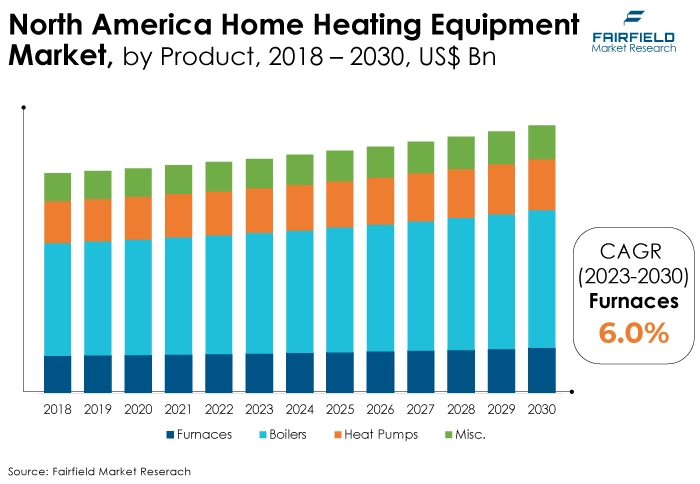
Fairfield’s Competitive Landscape Analysis
The global home heating equipment market is a competitive market with fewer major players present across the globe. The key players are introducing new products as well as working on the distribution channels to enhance their worldwide presence. Moreover, Fairfield Market Research is expecting the market to witness more consolidation over the coming years.
Who are the Leaders in the Global Home Heating Service Space?
- Carrier Corporation Trane Technologies plc.
- Daikin Industries Ltd.
- Lennox International Inc.
- Rheem Manufacturing Company
- Viessmann Group
- NIBE Industrier
- AB Vaillant Group
- Bosch Thermotechnology Ltd.
- Smith Corporation
- BullsEye Plumbing Heating & Air of Colorado Springs
- Advance Ventilation Pvt. Limited
- Multiline Industries Pvt. ltd.
- Ascent Aircon Pvt. Ltd.
- Global Ac System Jsr Pvt. Ltd.
- Febo Engineering (p) Ltd.
- Johnson Controls International
Significant Company Developments
New Product Launch & Distribution Agreements
- July 2022: The launch of a new electric infrared product line has been announced by a pioneer in cutting-edge HVAC heating solutions. Modine's portfolio of energy-efficient and low-emission heating solutions for a variety of commercial and residential applications is being expanded with the addition of this new product line.
- October 2022: Over the next three decades, greening the financial system (NGFS) would necessitate spending a total of US$275 Tn on material assets. This enormous opportunity offers leaders the chance to start and expand new green businesses that will change the world for a sustainable future.
- May 2021: The Fuel Distribution Agreement was made and entered into by and among CST Marketing and Supply LLC, CST Services LLC, and certain subsidiaries of the CST Services signatories.
An Expert’s Eye
Demand and Future Growth
As per Fairfield’s Analysis, the use of renewable energy sources in heating systems for homes is growing. Solar panels, geothermal heat pumps, and biomass heating are being used to reduce reliance on fossil fuels.
Hybrid heating systems that use both traditional and renewable energy sources are now part of the product and service offerings of service providers. Government initiatives and financial rewards significantly influence the market for home heating equipment.
Supply and Demand Side of the Market
According to our analysis, the US, and Canada are two major regions in the Home Heating Equipment industry. Their heating infrastructure is well-established, and they have a wide variety of heating systems. European nations with a focus on energy efficiency and sustainability, such as Germany, the UK, and France, have thriving home heating markets.
Nordic countries like Sweden and Norway emphasize efficient home heating systems, often using technologies like district heating. The main pieces of equipment in a heating system include furnaces, boilers, heat pumps, and other heating systems. These systems are manufactured using various components like metal casings, heat exchangers, and electronic controls.
Replacement parts that are particular to the model and manufacturer of the heating system are crucial for maintenance and repair work. These might consist of burners, heat exchanger coils, fans, and sensors.
Global Home Heating Equipment Market is Segmented as Below:
By Product:
- Furnaces
- Boilers
- Heat Pumps
- Miscellaneous
By Fuel:
- Natural Gas
- Heating Oil
- Electricity
- Biomass
- Miscellaneous
By Service:
- Repair
- Replacement
By Geographic Coverage:
- Asia Pacific
- U.S.
- Canada
- Europe
- Germany
- U.K.
- France
- Italy
- Turkey
- Russia
- Rest of Europe
- North America
- China
- Japan
- South Korea
- India
- Southeast Asia
- Rest of North America
- Latin America
- Brazil
- Mexico
- Argentina
- Rest of Latin America
- Middle East & Africa
- GCC
- South Africa
- Egypt
- Nigeria
- Rest of Middle East & Africa
1. Executive Summary
1.1. Global Home Heating Equipment Market
1.2. Future Projections
1.3. Key Market Trends
1.4. Regional Snapshot, by Value, 2022
1.5. Analyst Recommendations
2. Market Overview
2.1. Market Definitions and Segmentations
2.2. Market Dynamics
2.2.1. Drivers
2.2.2. Restraints
2.2.3. Market Opportunities
2.3. Value Chain Analysis
2.4. Porter’s Five Forces Analysis
2.5. COVID-19 Impact Analysis
2.5.1. Supply
2.5.2. Demand
2.6. Impact of Ukraine-Russia Conflict
2.7. Economic Overview
2.7.1. World Economic Projections
2.8. PESTLE Analysis
3. Global Home Heating Equipment Market Outlook, 2018 - 2030
3.1. Global Home Heating Equipment Market Outlook, by Product, Value (US$ Bn), 2018 - 2030
3.1.1. Key Highlights
3.1.1.1. Furnaces
3.1.1.2. Boilers
3.1.1.3. Heat Pumps
3.1.1.4. Misc.
3.2. Global Home Heating Equipment Market Outlook, by Fuel, Value (US$ Bn), 2018 - 2030
3.2.1. Key Highlights
3.2.1.1. Natural Gas
3.2.1.2. Heating Oil
3.2.1.3. Electricity
3.2.1.4. Biomass
3.2.1.5. Misc.
3.3. Global Home Heating Equipment Market Outlook, by Service, Value (US$ Bn), 2018 - 2030
3.3.1. Key Highlights
3.3.1.1. Repair
3.3.1.2. Replacement
3.4. Global Home Heating Equipment Market Outlook, by Region, Value (US$ Bn), 2018 - 2030
3.4.1. Key Highlights
3.4.1.1. North America
3.4.1.2. Europe
3.4.1.3. Asia Pacific
3.4.1.4. Latin America
3.4.1.5. Middle East & Africa
4. North America Home Heating Equipment Market Outlook, 2018 - 2030
4.1. North America Home Heating Equipment Market Outlook, by Product, Value (US$ Bn), 2018 - 2030
4.1.1. Key Highlights
4.1.1.1. Furnaces
4.1.1.2. Boilers
4.1.1.3. Heat Pumps
4.1.1.4. Misc.
4.2. North America Home Heating Equipment Market Outlook, by Fuel, Value (US$ Bn), 2018 - 2030
4.2.1. Key Highlights
4.2.1.1. Natural Gas
4.2.1.2. Heating Oil
4.2.1.3. Electricity
4.2.1.4. Biomass
4.2.1.5. Misc.
4.3. North America Home Heating Equipment Market Outlook, by Service, Value (US$ Bn), 2018 - 2030
4.3.1. Key Highlights
4.3.1.1. Repair
4.3.1.2. Replacement
4.3.2. BPS Analysis/Market Attractiveness Analysis
4.4. North America Home Heating Equipment Market Outlook, by Country, Value (US$ Bn), 2018 - 2030
4.4.1. Key Highlights
4.4.1.1. U.S. Home Heating Equipment Market by Product, Value (US$ Bn), 2018 - 2030
4.4.1.2. U.S. Home Heating Equipment Market by Fuel, Value (US$ Bn), 2018 - 2030
4.4.1.3. U.S. Home Heating Equipment Market by Service, Value (US$ Bn), 2018 - 2030
4.4.1.4. Canada Home Heating Equipment Market by Product, Value (US$ Bn), 2018 - 2030
4.4.1.5. Canada Home Heating Equipment Market by Fuel, Value (US$ Bn), 2018 - 2030
4.4.1.6. Canada Home Heating Equipment Market by Service, Value (US$ Bn), 2018 - 2030
4.4.2. BPS Analysis/Market Attractiveness Analysis
5. Europe Home Heating Equipment Market Outlook, 2018 - 2030
5.1. Europe Home Heating Equipment Market Outlook, by Product, Value (US$ Bn), 2018 - 2030
5.1.1. Key Highlights
5.1.1.1. Furnaces
5.1.1.2. Boilers
5.1.1.3. Heat Pumps
5.1.1.4. Misc.
5.2. Europe Home Heating Equipment Market Outlook, by Fuel, Value (US$ Bn), 2018 - 2030
5.2.1. Key Highlights
5.2.1.1. Natural Gas
5.2.1.2. Heating Oil
5.2.1.3. Electricity
5.2.1.4. Biomass
5.2.1.5. Misc.
5.3. Europe Home Heating Equipment Market Outlook, by Service, Value (US$ Bn), 2018 - 2030
5.3.1. Key Highlights
5.3.1.1. Repair
5.3.1.2. Replacement
5.3.2. BPS Analysis/Market Attractiveness Analysis
5.4. Europe Home Heating Equipment Market Outlook, by Country, Value (US$ Bn), 2018 - 2030
5.4.1. Key Highlights
5.4.1.1. Germany Home Heating Equipment Market by Product, Value (US$ Bn), 2018 - 2030
5.4.1.2. Germany Home Heating Equipment Market by Fuel, Value (US$ Bn), 2018 - 2030
5.4.1.3. Germany Home Heating Equipment Market by Service, Value (US$ Bn), 2018 - 2030
5.4.1.4. U.K. Home Heating Equipment Market by Product, Value (US$ Bn), 2018 - 2030
5.4.1.5. U.K. Home Heating Equipment Market by Fuel, Value (US$ Bn), 2018 - 2030
5.4.1.6. U.K. Home Heating Equipment Market by Service, Value (US$ Bn), 2018 - 2030
5.4.1.7. France Home Heating Equipment Market by Product, Value (US$ Bn), 2018 - 2030
5.4.1.8. France Home Heating Equipment Market by Fuel, Value (US$ Bn), 2018 - 2030
5.4.1.9. France Home Heating Equipment Market by Service, Value (US$ Bn), 2018 - 2030
5.4.1.10. Italy Home Heating Equipment Market by Product, Value (US$ Bn), 2018 - 2030
5.4.1.11. Italy Home Heating Equipment Market by Fuel, Value (US$ Bn), 2018 - 2030
5.4.1.12. Italy Home Heating Equipment Market by Service, Value (US$ Bn), 2018 - 2030
5.4.1.13. Turkey Home Heating Equipment Market by Product, Value (US$ Bn), 2018 - 2030
5.4.1.14. Turkey Home Heating Equipment Market by Fuel, Value (US$ Bn), 2018 - 2030
5.4.1.15. Turkey Home Heating Equipment Market by Service, Value (US$ Bn), 2018 - 2030
5.4.1.16. Russia Home Heating Equipment Market by Product, Value (US$ Bn), 2018 - 2030
5.4.1.17. Russia Home Heating Equipment Market by Fuel, Value (US$ Bn), 2018 - 2030
5.4.1.18. Russia Home Heating Equipment Market by Service, Value (US$ Bn), 2018 - 2030
5.4.1.19. Rest of Europe Home Heating Equipment Market by Product, Value (US$ Bn), 2018 - 2030
5.4.1.20. Rest of Europe Home Heating Equipment Market by Fuel, Value (US$ Bn), 2018 - 2030
5.4.1.21. Rest of Europe Home Heating Equipment Market by Service, Value (US$ Bn), 2018 - 2030
5.4.2. BPS Analysis/Market Attractiveness Analysis
6. Asia Pacific Home Heating Equipment Market Outlook, 2018 - 2030
6.1. Asia Pacific Home Heating Equipment Market Outlook, by Product, Value (US$ Bn), 2018 - 2030
6.1.1. Key Highlights
6.1.1.1. Furnaces
6.1.1.2. Boilers
6.1.1.3. Heat Pumps
6.1.1.4. Misc.
6.2. Asia Pacific Home Heating Equipment Market Outlook, by Fuel, Value (US$ Bn), 2018 - 2030
6.2.1. Key Highlights
6.2.1.1. Natural Gas
6.2.1.2. Heating Oil
6.2.1.3. Electricity
6.2.1.4. Biomass
6.2.1.5. Misc.
6.3. Asia Pacific Home Heating Equipment Market Outlook, by Service, Value (US$ Bn), 2018 - 2030
6.3.1. Key Highlights
6.3.1.1. Repair
6.3.1.2. Replacement
6.3.2. BPS Analysis/Market Attractiveness Analysis
6.4. Asia Pacific Home Heating Equipment Market Outlook, by Country, Value (US$ Bn), 2018 - 2030
6.4.1. Key Highlights
6.4.1.1. China Home Heating Equipment Market by Product, Value (US$ Bn), 2018 - 2030
6.4.1.2. China Home Heating Equipment Market by Fuel, Value (US$ Bn), 2018 - 2030
6.4.1.3. China Home Heating Equipment Market by Service, Value (US$ Bn), 2018 - 2030
6.4.1.4. Japan Home Heating Equipment Market by Product, Value (US$ Bn), 2018 - 2030
6.4.1.5. Japan Home Heating Equipment Market by Fuel, Value (US$ Bn), 2018 - 2030
6.4.1.6. Japan Home Heating Equipment Market by Service, Value (US$ Bn), 2018 - 2030
6.4.1.7. South Korea Home Heating Equipment Market by Product, Value (US$ Bn), 2018 - 2030
6.4.1.8. South Korea Home Heating Equipment Market by Fuel, Value (US$ Bn), 2018 - 2030
6.4.1.9. South Korea Home Heating Equipment Market by Service, Value (US$ Bn), 2018 - 2030
6.4.1.10. India Home Heating Equipment Market by Product, Value (US$ Bn), 2018 - 2030
6.4.1.11. India Home Heating Equipment Market by Fuel, Value (US$ Bn), 2018 - 2030
6.4.1.12. India Home Heating Equipment Market by Service, Value (US$ Bn), 2018 - 2030
6.4.1.13. Southeast Asia Home Heating Equipment Market by Product, Value (US$ Bn), 2018 - 2030
6.4.1.14. Southeast Asia Home Heating Equipment Market by Fuel, Value (US$ Bn), 2018 - 2030
6.4.1.15. Southeast Asia Home Heating Equipment Market by Service, Value (US$ Bn), 2018 - 2030
6.4.1.16. Rest of Asia Pacific Home Heating Equipment Market by Product, Value (US$ Bn), 2018 - 2030
6.4.1.17. Rest of Asia Pacific Home Heating Equipment Market by Fuel, Value (US$ Bn), 2018 - 2030
6.4.1.18. Rest of Asia Pacific Home Heating Equipment Market by Service, Value (US$ Bn), 2018 - 2030
6.4.2. BPS Analysis/Market Attractiveness Analysis
7. Latin America Home Heating Equipment Market Outlook, 2018 - 2030
7.1. Latin America Home Heating Equipment Market Outlook, by Product, Value (US$ Bn), 2018 - 2030
7.1.1. Key Highlights
7.1.1.1. Furnaces
7.1.1.2. Boilers
7.1.1.3. Heat Pumps
7.1.1.4. Misc.
7.2. Latin America Home Heating Equipment Market Outlook, by Fuel, Value (US$ Bn), 2018 - 2030
7.2.1. Key Highlights
7.2.1.1. Natural Gas
7.2.1.2. Heating Oil
7.2.1.3. Electricity
7.2.1.4. Biomass
7.2.1.5. Misc.
7.3. Latin America Home Heating Equipment Market Outlook, by Service, Value (US$ Bn), 2018 - 2030
7.3.1. Key Highlights
7.3.1.1. Repair
7.3.1.2. Replacement
7.3.2. BPS Analysis/Market Attractiveness Analysis
7.4. Latin America Home Heating Equipment Market Outlook, by Country, Value (US$ Bn), 2018 - 2030
7.4.1. Key Highlights
7.4.1.1. Brazil Home Heating Equipment Market by Product, Value (US$ Bn), 2018 - 2030
7.4.1.2. Brazil Home Heating Equipment Market by Fuel, Value (US$ Bn), 2018 - 2030
7.4.1.3. Brazil Home Heating Equipment Market by Service, Value (US$ Bn), 2018 - 2030
7.4.1.4. Mexico Home Heating Equipment Market by Product, Value (US$ Bn), 2018 - 2030
7.4.1.5. Mexico Home Heating Equipment Market by Fuel, Value (US$ Bn), 2018 - 2030
7.4.1.6. Mexico Home Heating Equipment Market by Service, Value (US$ Bn), 2018 - 2030
7.4.1.7. Argentina Home Heating Equipment Market by Product, Value (US$ Bn), 2018 - 2030
7.4.1.8. Argentina Home Heating Equipment Market by Fuel, Value (US$ Bn), 2018 - 2030
7.4.1.9. Argentina Home Heating Equipment Market by Service, Value (US$ Bn), 2018 - 2030
7.4.1.10. Rest of Latin America Home Heating Equipment Market by Product, Value (US$ Bn), 2018 - 2030
7.4.1.11. Rest of Latin America Home Heating Equipment Market by Fuel, Value (US$ Bn), 2018 - 2030
7.4.1.12. Rest of Latin America Home Heating Equipment Market by Service, Value (US$ Bn), 2018 - 2030
7.4.2. BPS Analysis/Market Attractiveness Analysis
8. Middle East & Africa Home Heating Equipment Market Outlook, 2018 - 2030
8.1. Middle East & Africa Home Heating Equipment Market Outlook, by Product, Value (US$ Bn), 2018 - 2030
8.1.1. Key Highlights
8.1.1.1. Furnaces
8.1.1.2. Boilers
8.1.1.3. Heat Pumps
8.1.1.4. Misc.
8.2. Middle East & Africa Home Heating Equipment Market Outlook, by Fuel, Value (US$ Bn), 2018 - 2030
8.2.1. Key Highlights
8.2.1.1. Natural Gas
8.2.1.2. Heating Oil
8.2.1.3. Electricity
8.2.1.4. Biomass
8.2.1.5. Misc.
8.3. Middle East & Africa Home Heating Equipment Market Outlook, by Service, Value (US$ Bn), 2018 - 2030
8.3.1. Key Highlights
8.3.1.1. Repair
8.3.1.2. Replacement
8.3.2. BPS Analysis/Market Attractiveness Analysis
8.4. Middle East & Africa Home Heating Equipment Market Outlook, by Country, Value (US$ Bn), 2018 - 2030
8.4.1. Key Highlights
8.4.1.1. GCC Home Heating Equipment Market by Product, Value (US$ Bn), 2018 - 2030
8.4.1.2. GCC Home Heating Equipment Market by Fuel, Value (US$ Bn), 2018 - 2030
8.4.1.3. GCC Home Heating Equipment Market by Service, Value (US$ Bn), 2018 - 2030
8.4.1.4. South Africa Home Heating Equipment Market by Product, Value (US$ Bn), 2018 - 2030
8.4.1.5. South Africa Home Heating Equipment Market by Fuel, Value (US$ Bn), 2018 - 2030
8.4.1.6. South Africa Home Heating Equipment Market by Service, Value (US$ Bn), 2018 - 2030
8.4.1.7. Egypt Home Heating Equipment Market by Product, Value (US$ Bn), 2018 - 2030
8.4.1.8. Egypt Home Heating Equipment Market by Fuel, Value (US$ Bn), 2018 - 2030
8.4.1.9. Egypt Home Heating Equipment Market by Service, Value (US$ Bn), 2018 - 2030
8.4.1.10. Nigeria Home Heating Equipment Market by Product, Value (US$ Bn), 2018 - 2030
8.4.1.11. Nigeria Home Heating Equipment Market by Fuel, Value (US$ Bn), 2018 - 2030
8.4.1.12. Nigeria Home Heating Equipment Market by Service, Value (US$ Bn), 2018 - 2030
8.4.1.13. Rest of Middle East & Africa Home Heating Equipment Market by Product, Value (US$ Bn), 2018 - 2030
8.4.1.14. Rest of Middle East & Africa Home Heating Equipment Market by Fuel, Value (US$ Bn), 2018 - 2030
8.4.1.15. Rest of Middle East & Africa Home Heating Equipment Market by Service, Value (US$ Bn), 2018 - 2030
8.4.2. BPS Analysis/Market Attractiveness Analysis
9. Competitive Landscape
9.1. Manufacturer vs Product Heatmap
9.2. Company Market Share Analysis, 2022
9.3. Competitive Dashboard
9.4. Company Profiles
9.4.1. Daikin Industries Ltd.
9.4.1.1. Company Overview
9.4.1.2. Product Portfolio
9.4.1.3. Financial Overview
9.4.1.4. Business Strategies and Development
9.4.2. Carrier Corporation
9.4.2.1. Company Overview
9.4.2.2. Product Portfolio
9.4.2.3. Financial Overview
9.4.2.4. Business Strategies and Development
9.4.3. Trane Technologies plc
9.4.3.1. Company Overview
9.4.3.2. Product Portfolio
9.4.3.3. Financial Overview
9.4.3.4. Business Strategies and Development
9.4.4. Johnson Controls International plc
9.4.4.1. Company Overview
9.4.4.2. Product Portfolio
9.4.4.3. Financial Overview
9.4.4.4. Business Strategies and Development
9.4.5. Rheem Manufacturing Company
9.4.5.1. Company Overview
9.4.5.2. Product Portfolio
9.4.5.3. Financial Overview
9.4.5.4. Business Strategies and Development
9.4.6. VIESSMANN GROUP
9.4.6.1. Company Overview
9.4.6.2. Product Portfolio
9.4.6.3. Financial Overview
9.4.6.4. Business Strategies and Development
9.4.7. NIBE Industrier AB
9.4.7.1. Company Overview
9.4.7.2. Product Portfolio
9.4.7.3. Financial Overview
9.4.7.4. Business Strategies and Development
9.4.8. Vaillant Group
9.4.8.1. Company Overview
9.4.8.2. Product Portfolio
9.4.8.3. Business Strategies and Development
9.4.9. Bosch Thermotechnology Ltd.
9.4.9.1. Company Overview
9.4.9.2. Product Portfolio
9.4.9.3. Financial Overview
9.4.9.4. Business Strategies and Development
9.4.10. O. Smith Corporation
9.4.10.1. Company Overview
9.4.10.2. Product Portfolio
9.4.10.3. Financial Overview
9.4.10.4. Business Strategies and Development
9.4.11. BullsEye Plumbing Heating & Air of Colorado Springs
9.4.11.1. Company Overview
9.4.11.2. Product Portfolio
9.4.11.3. Financial Overview
9.4.11.4. Business Strategies and Development
9.4.12. Advance Ventilation Pvt. Limited
9.4.12.1. Overview
9.4.12.2. Product Portfolio
9.4.12.3. Financial Overview
9.4.12.4. Business Strategies and Development
9.4.13. Multiline Industries Pvt. ltd.
9.4.13.1. Company Overview
9.4.13.2. Product Portfolio
9.4.13.3. Financial Overview
9.4.13.4. Business Strategies and Development
9.4.14. Ascent Aircon Pvt. Ltd.
9.4.14.1. Company Overview
9.4.14.2. Product Portfolio
9.4.14.3. Financial Overview
9.4.14.4. Business Strategies and Development
9.4.15. Global Ac System Jsr Pvt Ltd
9.4.15.1. Company Overview
9.4.15.2. Product Portfolio
9.4.15.3. Financial Overview
9.4.15.4. Business Strategies and Development
10. Appendix
10.1. Research Methodology
10.2. Report Assumptions
10.3. Acronyms and Abbreviations
|
BASE YEAR |
HISTORICAL DATA |
FORECAST PERIOD |
UNITS |
|||
|
2022 |
|
2018 - 2022 |
2023 - 2030 |
Value: US$ Million |
||
|
REPORT FEATURES |
DETAILS |
|
Product Coverage |
|
|
Fuel Coverage |
|
|
Service Coverage |
|
|
Geographical Coverage |
|
|
Leading Companies |
|
|
Report Highlights |
Key Market Indicators, Macro-micro economic impact analysis, Technological Roadmap, Key Trends, Driver, Restraints, and Future Opportunities & Revenue Pockets, Porter’s 5 Forces Analysis, Historical Trend (2019-2021), Market Estimates and Forecast, Market Dynamics, Industry Trends, Competition Landscape, Category, Region, Country- wise Trends & Analysis, COVID-19 Impact Analysis (Demand and Supply Chain) |
